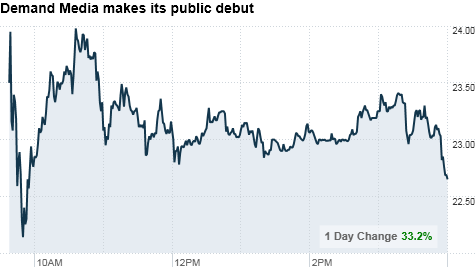Search News
 Click the chart for more on Demand Media stock.
Click the chart for more on Demand Media stock.
NEW YORK (CNNMoney) -- Shares of online content creator Demand Media closed 33% higher Wednesday, following an IPO that valued Demand at more than $1 billion.
The offering included 8.9 million shares, with Demand selling 4.5 million shares at $17 per share. Existing shareholders sold another 4.4 million shares -- a last-minute boost over the 3 million shares they intended to sell. Demand Media also raised the offering price beyond the anticipated $14 to $16 range.
Demand said it expects to raise around $67 million from the sale, after deducting its expenses for the IPO. The company plans to use the proceeds for content investments, working capital and international expansion.
The company trades on the New York Stock Exchange under the ticker symbol DMD (DMD). Shares ended at $22.65 Wednesday, after touching a high of $25.
That gives Demand a valuation of $1.5 billion -- more than the New York Times Co (NYT)., though less than other media stalwarts like Gannett Co. (GCI, Fortune 500) and Washington Post Co (WPO, Fortune 500).
That's also the highest market capitalization for an Internet company since Google's IPO in 2004, according to research firm Renaissance Capital.
How Demand works: Demand hires a stable of freelancers -- 13,000 are currently active -- to create content at rock-bottom rates, typically $15 for an article of several hundred words or $30 for a video.
Demand then sells ads around the content. Most of the articles appear on network of sites Demand owns, including eHow. Some traditional media companies, such as USAToday.com and the San Francisco Chronicle, also have licensed the content.
Demand's Google problem (and vice versa): Demand articles are meant to appear high in search engine results -- but Google (GOOG, Fortune 500) has said that it is changing its algorithm to improve search results.
"We hear the feedback from the Web loud and clear: people are asking for even stronger action on content farms and sites that consist primarily of spammy or low-quality content," the company said in a blog post last week.
Danny Sullivan, the editor of the Search Engine Land blog, said Google's post "definitely cast a cloud over [Demand's operations]."
"It wasn't an execution order, but Google is definitely looking more closely at these content farms," he added. "People have been complaining that search results are getting noisy. Demand says its content is good quality, but I've seen [mixed] results."
Twitter lit up with scathing comments from tech industry luminaries. "Hooray for crappy, SEO-driven content!" wrote Tadas Viskanta, who blogs at Abnormal Returns.
But some analysts are bullish on Demand. Wedbush Securities analyst Lou Kerner posted a defense of Demand via Business Insider, saying he was "impressed with the creativity of their business model, and more impressed by their traffic growth."
Demand said Wednesday that its owned and operated websites make up the 17th largest web property in the U.S. as of November 30, citing data from Internet tracker comScore. In that month, Demand properties had 105 million unique visitors, with 679 million pageviews globally.
In addition, about half of the Demand's revenue comes from its Internet registry business, where it manages 10 million domain names. Demand has also experimented with online publishing and social media tools.
Accounting questions: For years executives at Demand had said publicly that the company is profitable. But in its IPO filing in August, Demand disclosed that it was more than $6 million in the red for 2010 so far. It posted a net loss of $22 million in 2009 and millions more the previous two years.
The company has also faced criticism of its unorthodox accounting methods. Demand doesn't expense the cost of paying its writers upfront, as content companies typically do. Instead, it spreads those costs over five years, which boosts its bottom line.
Demand's rationale is that the writers' content will generate revenue for the company revenue for multiple years, so it shouldn't have to recognize the costs upfront. It estimates the "average useful life" -- meaning the amount of time it will make money -- of its content to be 5.4 years. ![]()






| Index | Last | Change | % Change |
|---|---|---|---|
| Dow | 32,627.97 | -234.33 | -0.71% |
| Nasdaq | 13,215.24 | 99.07 | 0.76% |
| S&P 500 | 3,913.10 | -2.36 | -0.06% |
| Treasuries | 1.73 | 0.00 | 0.12% |
| Company | Price | Change | % Change |
|---|---|---|---|
| Ford Motor Co | 8.29 | 0.05 | 0.61% |
| Advanced Micro Devic... | 54.59 | 0.70 | 1.30% |
| Cisco Systems Inc | 47.49 | -2.44 | -4.89% |
| General Electric Co | 13.00 | -0.16 | -1.22% |
| Kraft Heinz Co | 27.84 | -2.20 | -7.32% |
|
Bankrupt toy retailer tells bankruptcy court it is looking at possibly reviving the Toys 'R' Us and Babies 'R' Us brands. More |
Land O'Lakes CEO Beth Ford charts her career path, from her first job to becoming the first openly gay CEO at a Fortune 500 company in an interview with CNN's Boss Files. More |
Honda and General Motors are creating a new generation of fully autonomous vehicles. More |
In 1998, Ntsiki Biyela won a scholarship to study wine making. Now she's about to launch her own brand. More |
Whether you hedge inflation or look for a return that outpaces inflation, here's how to prepare. More |